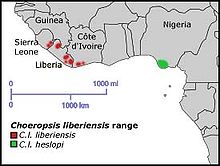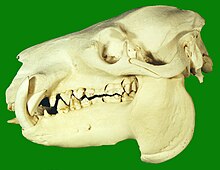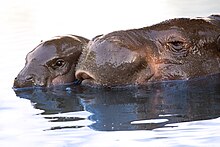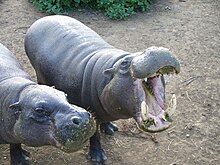Animal That Looks Like a Small Hippo
| Pygmy hippopotamus | |
|---|---|
 | |
| A pygmy hippopotamus at Bristol Zoo | |
| Scientific nomenclature | |
| Kingdom: | Animalia |
| Phylum: | Chordata |
| Class: | Mammalia |
| Order: | Artiodactyla |
| Family unit: | Hippopotamidae |
| Subfamily: | Hippopotaminae |
| Genus: | Choeropsis Leidy, 1853 |
| Species: | C. liberiensis |
| Binomial name | |
| Choeropsis liberiensis | |
| Subspecies | |
| |
 | |
| Range map [1] | |
| Synonyms [1] | |
| |
The pygmy hippopotamus (Choeropsis liberiensis) is a small-scale hippopotamid which is native to the forests and swamps of West Africa, primarily in Liberia, with small populations in Sierra Leone, Republic of guinea, and Ivory coast. It has been extirpated from Nigeria. [i]
The pygmy hippo is reclusive and nocturnal. Information technology is one of only two extant species in the family Hippopotamidae, the other being its much larger relative, the common hippopotamus (Hippopotamus amphibius) or Nile hippopotamus. The pygmy hippopotamus displays many terrestrial adaptations, but like the hippo, information technology is semiaquatic and relies on water to keep its skin moist and its body temperature cool. Behaviors such every bit mating and giving birth may occur in water or on land. The pygmy hippo is herbivorous, feeding on ferns, wide-leaved plants, grasses, and fruits it finds in the forests.
A rare nocturnal forest animate being, the pygmy hippopotamus is a hard animal to study in the wild. Pygmy hippos were unknown outside West Africa until the 19th century. Introduced to zoos in the early 20th century, they breed well in captivity and the vast majority of research is derived from zoo specimens. [4] The survival of the species in captivity is more bodacious than in the wild; in a 2015 assessment, the International Spousal relationship for Conservation of Nature estimated that fewer than two,500 pygmy hippos remain in the wild. [one]
Pygmy hippos are primarily threatened past loss of habitat, as forests are logged and converted to farm country, and are also vulnerable to poaching, hunting for bushmeat, natural predators, and state of war. Pygmy hippos are among the species illegally hunted for food in Liberia.
Taxonomy and origins [ edit ]
Nomenclature of the pygmy hippopotamus reflects that of the hippopotamus; the plural form is pygmy hippopotamuses or pygmy hippopotami. [5] A male pygmy hippopotamus is known equally a bull, a female person as a moo-cow, and a baby every bit a calf. A group of hippopotami is known as a herd or a bloat. [6]
The pygmy hippopotamus is a fellow member of the family unit Hippopotamidae where it is classified every bit a member of the genus Choeropsis ("resembling a hog"). Members of Hippopotamidae are sometimes known every bit hippopotamids. Sometimes the sub-family Hippopotaminae is used. Farther, some taxonomists group hippopotami and anthracotheres in the superfamily Anthracotheroidea or Hippopotamoidea.
A sis species of the pygmy hippopotamus may have been the little-studied Malagasy pygmy hippopotamus (Hippopotamus madagascariensis), one of three recently extinct species from Madagascar. H. madagascariensis was the aforementioned size every bit C. liberiensis and shared its terrestrial beliefs, inhabiting the forested highlands of Madagascar, rather than open rivers. Information technology is believed to have gone extinct within the last 500 years. [7] [8] [nine]
The taxonomy of the genus of the pygmy hippopotamus has changed as understanding of the animal has adult. [one] [x] [xi] [12] Samuel M. Morton initially classified the animal every bit Hippopotamus minor, but later determined it was singled-out enough to warrant its ain genus, and labeled it Choeropsis. In 1977, Shirley C. Coryndon proposed that the pygmy hippopotamus was closely related to Hexaprotodon, a genus that consisted of prehistoric hippos mostly native to Asia. [thirteen]
This assertion was widely accepted, [one] [10] [11] [12] until Boisserie asserted in 2005 that the pygmy hippopotamus was non a fellow member of Hexaprotodon, after a thorough exam of the phylogeny of Hippopotamidae. He suggested instead that the pygmy hippopotamus was a distinct genus, and returned the animal to Choeropsis. [10] [14] [15] ITIS verifies Hexaprotodon liberiensis every bit the valid scientific name. [sixteen] All concord that the modern pygmy hippopotamus, be it H. liberiensis or C. liberiensis, is the only extant fellow member of its genus. [10] [13] The American Club of Mammalogists moved it back to Choeropsis in 2022, [3] a motility supported past the IUCN. [1]
Nigerian subspecies [ edit ]
A distinct subspecies of pygmy hippopotamus existed in Nigeria until at least the 20th century, though the validity of this has been questioned. [ane] The existence of the subspecies, makes Choeropsis liberiensis liberiensis (or Hexaprotodon liberiensis liberiensis under the old classification) the full trinomial classification for the Liberian pygmy hippopotamus. The Nigerian pygmy hippopotamus was never studied in the wild and never captured. All research and all zoo specimens are the Liberian subspecies. The Nigerian subspecies is classified as C. liberiensis heslopi. [xi]
The Nigerian pygmy hippopotamus ranged in the Niger River Delta, especially near Port Harcourt, but no reliable reports exist afterward the drove of the museum specimens secured by I. R. P. Heslop, a British colonial officeholder, in the early on 1940s. Information technology is probably extinct. [ane] The subspecies is separated by over 1,800 km (1,100 mi) and the Dahomey Gap, a region of savanna that divides the wood regions of West Africa. The subspecies is named after I. R. P. Heslop, who claimed in 1945 to take shot a pygmy hippo in the Niger Delta region and nerveless several skulls. He estimated that maybe no more 30 pygmy hippos remained in the region. [17]
Heslop reportedly sent four pygmy hippopotamus skulls he collected to the British Museum of Natural History in London. These specimens were not subjected to taxonomic evaluation, notwithstanding, until 1969 when G. B. Corbet classified the skulls equally belonging to a separate subspecies based on consistent variations in the proportions of the skulls. [eighteen] The Nigerian pygmy hippos were seen or shot in Rivers State, Imo State and Bayelsa Land, Nigeria. While some local populations are enlightened that the species one time existed, its history in the region is poorly documented. [11]
Evolution [ edit ]
The evolution of the pygmy hippopotamus is most frequently studied in the context of its larger cousin. Both species were long believed to be most closely related to the family Suidae (pigs and hogs) or Tayassuidae (peccaries), only enquiry within the last 10 years has determined that pygmy hippos and hippos are nigh closely related to cetaceans (whales and dolphins). Hippos and whales shared a common semi-aquatic ancestor that branched off from other artiodactyls around lx mya. [19] [20]
This hypothesized ancestor likely carve up into ii branches nigh vi meg years later on. [21] One co-operative would evolve into cetaceans, the other branch became the anthracotheres, a big family of four-legged beasts, whose earliest member, from the Late Eocene, would have resembled narrow hippopotami with comparatively small and thin heads. [14]
Hippopotamids are deeply nested within the family Anthracotheriidae. The oldest known hippopotamid is the genus Kenyapotamus , which lived in Africa from 16 to eight mya. Kenyapotamus is known just through fragmentary fossils, just was like in size to C. liberiensis. [15] The Hippopotamidae are believed to take evolved in Africa, and while at one indicate the species spread across Asia and Europe, no hippopotami have ever been discovered in the Americas. Starting 7.5 to ane.8 mya the Archaeopotamus , probable ancestors to the genus Hippopotamus and Hexaprotodon , lived in Africa and the Middle East. [10]
While the fossil tape of hippos is still poorly understood, the lineages of the two modern genera, Hippopotamus and Choeropsis, may take diverged every bit far dorsum as 8 mya. The bequeathed class of the pygmy hippopotamus may exist the genus Saotherium. Saotherium and Choeropsis are significantly more basal than Hippopotamus and Hexaprotodon, and thus more than closely resemble the ancestral species of hippos. [10] [xv]
Extinct pygmy and dwarf hippos [ edit ]
Several species of small hippopotamids accept too become extinct in the Mediterranean in the belatedly Pleistocene or early Holocene. Though these species are sometimes known as "pygmy hippopotami" they are not believed to be closely related to C. liberiensis. These include the Cretan dwarf hippopotamus (Hippopotamus creutzburgi), the Sicilian hippopotamus ( Hippopotamus pentlandi ), the Maltese hippopotamus ( Hippopotamus melitensis ) and the Cyprus dwarf hippopotamus (Hippopotamus small). [22]
These species, though comparable in size to the pygmy hippopotamus, are considered dwarf hippopotamuses, rather than pygmies. They are likely descended from a full-sized species of European hippopotamus, and reached their small size through the evolutionary procedure of insular dwarfism which is mutual on islands; the ancestors of pygmy hippopotami were also small and thus at that place was never a dwarfing process. [22] There were also several species of pygmy hippo on the isle of Madagascar (encounter Malagasy hippopotamus).
Description [ edit ]
Pygmy hippos share the same full general form as a hippopotamus. They have a graviportal skeleton, with four stubby legs and four toes on each foot, supporting a portly frame. The pygmy hippo, all the same, is just half every bit tall as the hippopotamus and weighs less than ane/4 as much as its larger cousin. Adult pygmy hippos stand nigh 75–100 cm (2.46–3.28 ft) high at the shoulder, are 150–175 cm (4.92–five.74 ft) in length and weigh 180–275 kg (397–606 lb). [23] Their lifespan in captivity ranges from 30 to 55 years, though it is unlikely that they live this long in the wild. [eleven] [24]
The skin is greenish-black or brown, shading to a flossy gray on the lower body. Their skin is very like to the common hippo's, with a thin epidermis over a dermis that is several centimeters thick. Pygmy hippos take the same unusual secretion as mutual hippos, that gives a pinkish tinge to their bodies, and is sometimes described as "blood sweat" though the secretion is neither sweat nor claret. This substance, hipposudoric acid, is believed to have antiseptic and sunscreening properties. The skin of hippos dries out speedily and cracks, which is why both species spend so much time in water. [11]
The skeleton of C. liberiensis is more than gracile than that of the common hippopotamus, pregnant their bones are proportionally thinner. The common hippo'south spine is parallel with the footing; the pygmy hippo'due south back slopes forward, a likely adaptation to pass more easily through dense forest vegetation. Proportionally, the pygmy hippo'southward legs and cervix are longer and its caput smaller. [24]
The orbits and nostrils of a pygmy hippo are much less pronounced, an adaptation from spending less time in deep water (where pronounced orbits and nostrils help the common hippo breathe and run into). The feet of pygmy hippos are narrower, but the toes are more spread out and have less webbing, to assist in walking on the forest floor. [24]
Despite adaptations to a more than terrestrial life than the common hippopotamus, pygmy hippos are still more aquatic than all other even-toed ungulates. The ears and nostrils of pygmy hippos have strong muscular valves to aid submerging underwater, and the skin physiology is dependent on the availability of h2o. [11] [12]
Behavior [ edit ]
The behavior of the pygmy hippo differs from the common hippo in many ways. Much of its beliefs is more similar to that of a tapir, though this is an effect of convergent development. [12] While the common hippopotamus is gregarious, pygmy hippos live either lone or in pocket-sized groups, typically a mated pair or a female parent and calf. Pygmy hippos tend to ignore each other rather than fight when they come across. Field studies have estimated that male pygmy hippos range over 1.85 km2 (460 acres), while the range of a female person is 0.4 to 0.6 km2 (100–150 acres). [11]
Pygmy hippos spend well-nigh of the day hidden in rivers. They will rest in the same spot for several days in a row, earlier moving to a new spot. At least some pygmy hippos make use of dens or burrows that form in river banks. It is unknown if the pygmy hippos assist create these dens, or how common it is to use them. Though a pygmy hippo has never been observed burrowing, other artiodactyls, such equally warthogs, are burrowers. [11]
Diet [ edit ]
Like the common hippopotamus, the pygmy hippo emerges from the h2o at sunset to feed. Information technology relies on game trails to travel through dense wood vegetation. Information technology marks trails by vigorously waving its tail while defecating to further spread its feces. The pygmy hippo spends near six hours a day foraging for food. [11]
Pygmy hippos are herbivorous. They do not swallow aquatic vegetation to a significant extent and rarely swallow grass because it is uncommon in the thick forests they inhabit. The bulk of a pygmy hippo's diet consists of ferns, broad-leaved plants and fruits that have fallen to the forest floor. The wide variety of plants pygmy hippos have been observed eating suggests that they will eat any plants available. This diet is of higher quality than that of the common hippopotamus. [11]
Reproduction [ edit ]
A study of convenance behavior in the wild has never been conducted; the bogus conditions of captivity may cause the observed beliefs of pygmy hippos in zoos to differ from natural atmospheric condition. Sexual maturity for the pygmy hippopotamus occurs betwixt three and five years of age. [12] The youngest reported age for giving birth is a pygmy hippo in the Zoo Basel, Switzerland which diameter a calf at three years and 3 months. [11] The oestrus cycle of a female pygmy hippo lasts an boilerplate of 35.5 days, with the oestrus itself lasting between 24 and 48 hours. [one] [25]
Pygmy hippos consort for mating, but the elapsing of the relationship is unknown. In zoos they breed as monogamous pairs. Copulation can take place on country or in the water, and a pair will mate i to 4 times during an heat menses. In captivity, pygmy hippos have been conceived and born in all months of the year. [12] The gestation period ranges from 190 to 210 days, and ordinarily a single immature is born, though twins are known to occur. [11]
The mutual hippopotamus gives birth and mates simply in the water, merely pygmy hippos mate and give birth on both country and water. Young pygmy hippos tin can swim most immediately. At birth, pygmy hippos weigh 4.5–6.2 kg (9.9–thirteen.7 lb) with males weighing about 0.25 kg (0.55 lb) more than females. Pygmy hippos are fully weaned between six and eight months of age; before weaning they practise not accompany their mother when she leaves the water to forage, but instead hide in the water by themselves. The mother returns to the hiding spot well-nigh three times a day and calls out for the calf to suckle. Suckling occurs with the female parent lying on her side. [11]
Conservation [ edit ]
The greatest threat to the remaining pygmy hippopotamus population in the wild is loss of habitat. The forests in which pygmy hippos live have been field of study to logging, settling and conversion to agronomics, with little efforts made to brand logging sustainable. As forests shrink, the populations become more than fragmented, leading to less genetic diverseness in the potential mating pool. [1]
Pygmy hippos are among the species illegally hunted for food in Liberia. [26] Their meat is said to be of excellent quality, like that of a wild boar; different those of the common hippo, the pygmy hippo'due south teeth have no value. [12] The effects of West Africa'south civil strife on the pygmy hippopotamus are unknown, but unlikely to exist positive. [1] The pygmy hippopotamus tin can be killed past leopards, pythons and crocodiles. How often this occurs is unknown. [11]
C. liberiensis was identified as one of the top 10 "focal species" in 2007 by the Evolutionarily Distinct and Globally Endangered (Edge) project. [27] Some populations inhabit protected areas, such as the Gola Forest Reserve in Sierra Leone. [28]
Basel Zoo in Switzerland holds the international studbook and coordinates the entire convict pygmy hippo population that freely breeds in zoos around the world. Between 1970 and 1991 the population of pygmy hippos born in captivity more than doubled. The survival of the species in zoos is more certain than the survival of the species in the wild. [17] [24] In captivity, the pygmy hippo lives from 42 to 55 years, longer than in the wild. [11] Since 1919, only 41 per centum of pygmy hippos born in zoos have been male person. [25]
History and sociology [ edit ]
While the common hippopotamus was known to Europeans since classical antiquity, the pygmy hippopotamus was unknown outside its range in Westward Africa until the 19th century. Due to their nocturnal, forested existence, they were poorly known inside their range also. In Republic of liberia the animal was traditionally known as a water cow. [12]
Early field reports of the brute misidentified it every bit a wild pig. Several skulls of the species were sent to the American natural scientist Samuel G. Morton, during his residency in Monrovia, Liberia. Morton outset described the species in 1843. The starting time consummate specimens were collected equally part of a comprehensive investigation of Liberian fauna in the 1870s and 1880s by Dr. Johann Büttikofer. The specimens were taken to the Natural History Museum in Leiden, The Netherlands. [12]
The first pygmy hippo was brought to Europe in 1873 after beingness captured in Sierra Leone by a member of the British Colonial Service just died before long afterward inflow. Pygmy hippos were successfully introduced to Europe in 1911. They were first shipped to Germany and and so to the Bronx Zoo in New York City where they also thrived. [xi] [12]
In 1927, Harvey Firestone of Firestone Tires presented Billy the pygmy hippo to U.Due south. President Calvin Coolidge. Coolidge donated Billy to the National Zoo in Washington, D.C. According to the zoo, Billy is a common ancestor to most pygmy hippos in U.S. zoos today. [24] [29]
Several folktales take been collected about the pygmy hippopotamus. One tale says that pygmy hippos carry a shining diamond in their mouths to help travel through thick forests at nighttime; by twenty-four hours the pygmy hippo has a secret hiding place for the diamond, but if a hunter catches a pygmy hippo at dark the diamond can be taken. Villagers sometimes believed that infant pygmy hippos exercise not nurse but rather lick secretions off the pare of the mother. [12]
References [ edit ]
- ^ a b c d e f g h i j k l m Ransom, C.; Robinson, P.T.; Collen, B. (2015). "Choeropsis liberiensis". IUCN Ruby-red List of Threatened Species . 2015: e.T10032A18567171. doi: 10.2305/IUCN.UK.2015-2.RLTS.T10032A18567171.en . Retrieved 27 August 2022.
- ^ "Appendices | CITES". cites.org . Retrieved 2022-01-14 .
- ^ a b "Choeropsis liberiensis". ASM Mammal Diversity Database. 1.five. American Society of Mammalogists . Retrieved 26 August 2022.
- ^ Stroman, H. R.; Slaughter, L. Chiliad. (January 1972). "The intendance and breeding of the Pygmy hippopotamus (Choeropsis liberiensis) in captivity". International Zoo Yearbook. 12 (1): 126–131. doi:x.1111/j.1748-1090.1972.tb02296.x.
- ^ "Hippopotamus".
- ^ List of animal names
- ^ Harris, J.K. (1991). "Family Hippopotamidae". Koobi Fora Enquiry Project. Vol. three. The Fossil Ungulates: Geology, Fossil Artiodactyls and Paleoenvironments. Clarendon Press, Oxford: 31–85.
- ^ Oliver, W.Fifty.R. (1995). "Taxonomy and Conservation Status of the Suiformes — an Overview" (PDF). IBEX Journal of Mount Environmental. Archived from the original (PDF) on 2007-07-05.
- ^ Boisserie, J.-R. (2016). "Hippopotamus madagascariensis". IUCN Cherry-red List of Threatened Species . 2016: e.T40783A90128828. doi: 10.2305/IUCN.UK.2016-one.RLTS.T40783A90128828.en . Retrieved xi Nov 2022.
- ^ a b c d e f Boisserie, Jean-Renaud (2005). "The phylogeny and taxonomy of Hippopotamidae (Mammalia: Artiodactyla): a review based on morphology and cladistic analysis". Zoological Journal of the Linnean Guild . 143: 1–26. doi: 10.1111/j.1096-3642.2004.00138.x .
- ^ a b c d e f g h i j chiliad l grand n o p q Eltringham, S. Keith (1999). The Hippos. London: Academic Printing. ISBN 978-0-85661-131-v .
- ^ a b c d due east f k h i j k Robinson, Phillip T. River Horses and H2o Cows Archived 2009-03-26 at the Wayback Auto. Hippo Specialist Group of the Globe Conservation Spousal relationship Archived 2007-07-17 at the Wayback Automobile . Retrieved on 2007-07-30.
- ^ a b Coryndon, Shirley C. (1977). "The taxonomy and classification of the Hippopotamidae (Mammalia, Artiodactyla) and a clarification of two new fossil species". Proceedings of the Koninklijke Nederlandse Akademie van Wetenschappen. 80 (2): 61–88.
- ^ a b Boisserie, Jean-Renaud; Fabrice Lihoreau; Michel Brunet (February 2005). "The position of Hippopotamidae within Cetartiodactyla". Proceedings of the National Academy of Sciences . 102 (five): 1537–1541. Bibcode:2005PNAS..102.1537B. doi: ten.1073/pnas.0409518102 . PMC 547867 . PMID15677331.
- ^ a b c Boisserie, Jean-Renaud; Fabrice Lihoreau; Michel Brunet (March 2005). "Origins of Hippopotamidae (Mammalia, Cetartiodactyla): towards resolution". Zoologica Scripta . 34 (two): 119–143. doi:10.1111/j.1463-6409.2005.00183.x. S2CID83768668.
- ^ "ITIS Standard Study Page: Hexaprotodon liberiensis". www.itis.gov . Retrieved vii December 2022.
- ^ a b Eltringham, South. Keith (1993). "Pigs, Peccaries and Hippos Status Survey and Action Plan". World Conservation Union status survey. Archived from the original on 2008-01-05. Retrieved 2008-08-23 .
- ^ Corbet, Thousand. B. (1969). "The taxonomic status of the pygmy hippopotamus, Choeropsis liberiensis, from the Niger Delta". Journal of Zoology . 158 (three): 387–394. doi:10.1111/j.1469-7998.1969.tb02156.10.
- ^ "Scientists find missing link between the dolphin, whale and its closest relative, the hippo". Science News Daily. 2005-01-25. Archived from the original on 2007-03-04. Retrieved 2008-08-23 .
- ^ Gatesy, J (i May 1997). "More Deoxyribonucleic acid support for a Cetacea/Hippopotamidae clade: the blood-clotting protein factor gamma-fibrinogen". Molecular Biology and Evolution . 14 (five): 537–543. doi: 10.1093/oxfordjournals.molbev.a025790 . PMID9159931.
- ^ Ursing, B.M.; U. Arnason (1998). "Analyses of mitochondrial genomes strongly support a hippopotamus-whale clade". Proceedings of the Majestic Gild . 265 (1412): 2251–5. doi:10.1098/rspb.1998.0567. PMC 1689531 . PMID9881471.
- ^ a b Petronio, C. (1995). "Note on the taxonomy of Pleistocene hippopotamuses" (PDF). Ibex. 3: 53–55. Archived from the original (PDF) on 2008-09-12. Retrieved 2008-08-23 .
- ^ Macdonald, D. (2001). The New Encyclopedia of Mammals. Oxford University Press, Oxford. ISBN 978-0198508236 .
- ^ a b c d e "Pygmy Hippo fact sail". National Zoological Park. Archived from the original on 2008-08-25. Retrieved 2008-08-23 .
- ^ a b Zschokke, Samuel (2002). "Distorted Sex Ratio at Nascency in the Captive Pygmy Hippopotamus, Hexaprotodon Liberiensis". Journal of Mammalogy . 83 (3): 674–681. doi: ten.1644/1545-1542(2002)083<0674:DSRABI>2.0.CO;ii .
- ^ Look, Anne (eight May 2012). "Poaching in Liberia'southward Forests Threatens Rare Animals". Voice of America . Archived from the original on 4 March 2016. Retrieved 5 November 2014.
- ^ "Protection for 'weirdest' species". BBC . 2007-01-16. Retrieved 2008-08-23 .
- ^ Administrator. "Gola Forest Reserve". Visit Sierra Leone. Archived from the original on 2010-03-08.
- ^ Jablonski, Nina G. (2004). "The hippo'south tale: how the anatomy and physiology of Belatedly Neogene Hexaprotodon shed light on Late Neogene environmental change". Quaternary International . 117 (1): 119–123. Bibcode:2004QuInt.117..119J. doi:10.1016/S1040-6182(03)00121-vi.
External links [ edit ]
- Videos of Pygmy Hippos at Arkive.org
- Pygmy hippo defenseless on photographic camera in Liberia (video), BBC News 2011-12-19
- Rare pygmy hippos caught on film, BBC News 2008-03-x
- Camera trap results, Sapo National Park, Republic of liberia, Zoological Club of London (Border of Existence Programme). x March 2008. Commencement reports showing Pygmy Hippos in wild, surviving Liberian Civil War.
- Pygmy hippos survive two civil wars, Zoological Lodge of London Printing Release, 10 March 2008.
- Border of Existence "(Pygmy hippo)", Saving the Globe'due south most Evolutionarily Distinct and Globally Endangered (EDGE) species
Animal That Looks Like a Small Hippo
Source: https://en.wikipedia.org/wiki/Pygmy_hippopotamus












Komentar
Posting Komentar